Executive Summary
Recent developments in West Asia have instilled a feeling of deep insecurity in terms of global security. Nuclear weapons are a scientific marvel of the 20th century, embodying both the pinnacle of military deterrence and the ultimate destructive capability. Born out of the atomic age, these weapons harness immense energy which has the potential to send the whole world into extinction. The presence of nuclear weapons has at times kept conflicts at bay but their presence hangs like a sword over the head. A nuclear fatwa highlights the intersection of theology and international security, offering a different interpretation to understand a state’s religious stance. The thin beams of balance grow more precarious with each day passed in the anticipation of nuclear warfare.
This report is a study of Iran’s nuclear past. It lists possible reasons for Iran to seek a nuclear status and discusses how the dream to acquire nuclear power came into being. It lists Iran’s various overt and covert nuclear sites. It navigates through the blueprint of Iranian history of going nuclear and the repercussions it had to face because of it. It gives an account of the JCPOA and the sanctions that followed, which deteriorated the Iranian economy which is primarily based on it being a rentier state. The report analyzes the possibilities of Iran reviewing its nuclear doctrine as a call for the same has been made by 39 lawmakers in Iran. Officials have time and again voiced their need for assembling nuclear weapons for the sake of security. The report also discusses whether Iran will be the first to use nuclear weapons against Israel or whether Israel would outdo Iran in this matter. Things become interesting with the US Election Day coming up. Will Israel attack Iran’s nuclear and oil facilities; now that President Biden is at a vulnerable position, where he needs the Jewish support. It makes one wonder if an all out war is in the cards before November 5th?
Why would Iran want to go nuclear?
There are a myriad of reasons why a state would choose to go nuclear.
- Paranoia is a malady of the irrational; it builds on the fear and mistrust that one nation has towards the other. Pariah status of Iran adds on to its paranoia. Going nuclear has become a way for the state to manifest its capabilities and a means to project its power onto others in the vicinity and globally.
- Once a state becomes a nuclear power, its negotiating powers along with weightage of its words increases manifold. It transcends from being another cog in the machine to someone capable of destroying the whole world over and over.
- National Security has been at the forefront of every nuclear weapon possessing nation. States often like to masquerade their ambitions to possess nuclear weapons as a deterrent strategy. The fact that they are either at par with or better off than their adversary brings immense sense of security.
- Iran would not like to be dependent on any other country for its security, for instance Iran could not expect any help from the US or other western countries, given the ongoing sanctions and their historical relations that are imbibed in discord.
- For Iran, possessing a nuclear weapon has come to attach itself with nationalism, the need to protect the country and its culture is the motherboard of nationalism. People are ready to go to any lengths to save their country.
- Being a nuclear state makes a state stand out from the crowd and have an identity that is separate from the rest, Iran seeks to build a reputation for itself, to establish once and for all that it is no longer resembles the Iran in the immediate aftermath of the Islamic Revolution of 1979, where Iraq used chemical weapons against it.
- The IRGC views nuclear capability as a focal point of Iran’s strategic autonomy, for them, surrendering the nuclear program would be like surrendering their sovereignty.
- Iran began this program with the claims of it being for civilian purposes. Iran is essentially a rentier state that benefits tremendously from oil production but with an ever increasing population, the fossil fuel will run out at some point and a nuclear source would thereby increase energy and economic security.
- Iran and its proxies will be taken seriously, any state or non state actor would assess the risks involved by going against Iran and its proxies. Iran could use nuclear weapons as a leverage to secure its people.
- Israel’s military and technology made it a regional hegemon of sorts but with Iran coming into play, a shift in the power dynamics could be seen.
From Concept to a Reality: Iran’s Nuclear Blueprint
Iran’s nuclear program began under the pahlavi Dynasty in 1957, with the support of Mohamed Reza Shah when Iran signed an agreement with the US on civilian Nuclear cooperation. Under the “Atoms for Peace” initiative by the US government, President Eisenhower proposed to provide developing nations with research reactors, fuel and scientific training, required for civilian nuclear programs if the country agreed to use the education and the technology for peaceful purposes. This also allowed the US to gain allies in West Asia. The Shah established the Tehran Nuclear Research Center (TNRC), at the University of Tehran. In 1967, Iran was given a nuclear reactor by the US which had the capacity of producing 600 grams of plutonium per year. These tests were done in TNRC and in the 1990s Iran admitted to producing Plutoniums-210, which can be used to start a chain reaction in a nuclear weapon. The Shah established the Atomic Energy Organization of Iran (AEOI), which in an agreement with MIT saw the first set of nuclear engineers arrive in Iran.
This understanding took a dramatic turn after the Islamic Revolution of 1979 when President Carter let the ousted Shah receive treatment in the US, A hostage crisis for 15 months followed.
International Help
- In 1985 AQ Khan from Pakistan provided Iran with technical drawings of the P-1 centrifuge used to enrich uranium. Over the years he gave Iran access to 500 components for the same along with a more advanced P-2 centrifuge.Currently, the P-1 and P-2 centrifuges are used at Iran’s Natanz’s Fuel Enrichment plant, which is Iran’s largest enrichment facility.
- Kraftwerk, a German company, helped to complete one of the most significant projects for the country’s nuclear program. Built on the coast of the Persian Gulf, the Bushehr Nuclear Power Plant was meant to hold two nuclear reactors; Kraftwerk nearly finished one reactor when the Iranian Revolution broke out.
- In 1991, prior to being a member of the Nuclear Nonproliferation Treaty, China provided Iran with a huge quantity of uranium hexafluoride which is yet again used for Uranium enrichment. China also supplied Uranium tetrafluoride and Uranium dioxide to Iran. The Chinese supplied the Esfahan nuclear technology center, recognized as Iran’s largest nuclear research site, with two subcritical reactors—one 27 kilowatt thermal miniature reactor and one heavy water, zero power reactor.
- Iran built the Arak Heavy Water Reactor with Russian assistance. This has been at the center of P5+1 negotiations with Iran because of the potential of the reactor, which can produce plutonium used in weapons. NIKIET, a Russian research and design institute provided Iran with technology for fuel rods to be used in the reactor. Obninsk allegedly provides Iran with designs for the reactor.
In the early 2000s, Iran was building a nuclear weapons production complex coded as “Amad Plan”. The aim was to manufacture five nuclear weapons and prepare an underground nuclear test site, all to be finished by early 2004.The project was headed by Mohsen Fakhrizadeh, until his assassination. Under the plan Iran acquired several foreign weapon designs and refined them to develop its own, it conducted conventional explosives testing. In the year 2002, the National Council of Resistance of Iran, an umbrella organization made up of several Iranian dissident groups, revealed the existence of two Iranian nuclear sites- a uranium enrichment facility at Natanz and a heavy-water production facility at Arak. These were of dual nature, they could be used for civilian purposes as well as for manufacturing weapons of mass destruction. It is speculated that this event, followed by the US invasion of Iraq in 2003 under the pretext of Iraq possessing WMDs, led Iran to halt the Amad Plan.
This public disclosure of Arak and Natanz caused great worry to global leaders. In October, 2003 Iran struck a deal with the European countries whereby it agreed to stop the enrichment activities. Subsequently, it ratified an Additional Protocol for its safeguard with the IAEA. Iran did not follow through with the agreement, its declaration to IAEA in 2004 and 2005 had gaps and were inconsistent. Meanwhile Iran continued its enrichment activities. In 2005 the IAEA filed non-compliance on the part of Iran as its findings. By 2006, Iran had already begun to enrich Uranium up to 3.6%. The UNSC passed Resolution 1696 to express its concerns over Iran’s nuclear program and demanded Iran to stop Uranium enrichment.
The JCPOA
The Iran Nuclear Deal, known as the Joint Comprehensive Plan of Action, is an agreement between Iran and the P5+1 in 2015, with notable participation of the EU. The Western countries agreed to dial down the sanctions on a mutual understanding that Iran would deconstruct its nuclear program. The idea was to limit Iran and prevent another nuclear program as a means to reduce the probability of a standoff between Iran and its regional rivals like Israel and Saudi Arabia. The deal was scrapped in the year 2018 when the Trump administration pulled out of the deal. Iran agreed to stop enrichment activities and it ensured that- Fordow, Natanz, and Arak facilities would only pursue civilian work. The deal limited the numbers and types of centrifuges Iran can operate, the level of its enrichment. For instance Uranium enriched up to 5% can be used in nuclear power plants, further enrichment up to 20% means involvement in research reactors for medical purposes, enrichment up to 90% is used for manufacturing weapons. The IAEA became the monitoring body with access to overt and covert nuclear sites in order to keep Iran in check and away from being able to enrich uranium. The Western nations agreed to remove nuclear- related sanctions.
Under the deal, Iran’s commitments included:
- Operating no more than 5,060 IR-1 centrifuges for a period of 10 years
- Enrichment to no higher than 3.67 percent for a period of 15 years
- A stockpile of no more than 300 kilograms of enriched uranium for a period of 15 years
- No uranium enrichment at Fordow for a period of 15 years
- A re-design of the Arak Heavy Water Reactor to make it more proliferation-resistant
- Additional transparency measures including the eventual ratification of an Additional Protocol to its safeguards agreement
The P5+1 commitments included:
- The removal of almost all U.N. Security Council sanctions against Iran
- The suspension and eventual removal of most EU sanctions against Iran and a pledge to refrain from reintroducing sanctions suspended under the JCPOA.
- The suspension of some U.S. sanctions, including those against Iran’s energy and banking sectors.
If any signatory nation had suspicions over Iran’s intentions they could impose sanctions on Iran, this was to be in place till the next 10 years, after which all sanctions would be removed. In 2020 the US wanted to snap back to sanctions but the other signatories did not think it valid since Iran backed out in 2018. (Resolution 2231 provided for the “snap back” of U.N. sanctions against Iran in the event of significant non-compliance by one or more parties to the JCPOA). Iran started exceeding agreed-upon limits to its stockpile of low-enriched uranium in 2019, and began enriching uranium to higher concentrations. It also began developing new centrifuges to accelerate uranium enrichment; resuming heavy water production at its Arak facility; and enriching uranium at Fordow. After the assassination of general Qasem Soleimani, Iran announced that it would no longer abide by the restrictions posed by the deal. It began to construct a new centrifuge production center near Natanz to replace the one which was allegedly destroyed by Israel.
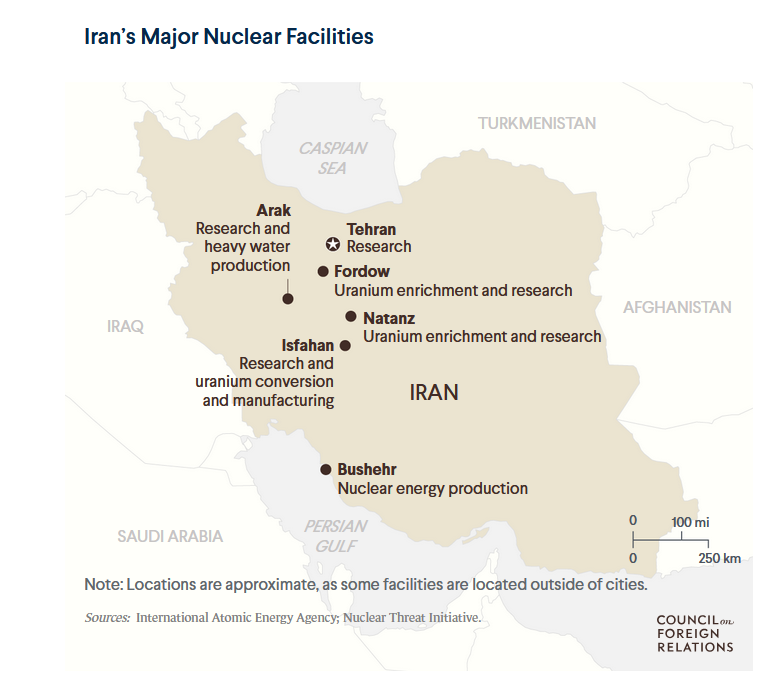
The Iranian economy suffered a turbulence when sanctions were imposed on it, its energy sector took the biggest hit and what followed was a period of recession, currency depletion and inflation. With the signing of the JCPOA, considerable relief was seen. Iran gained new partners in the form of European countries and its oil export saw a hike. The trade had started to reach its pre-sanctions era with Iran exporting 2.1 million barrels per day when the pinch was felt again with the US pulling out of the agreement. Over the years China filled the gap left by the US and started importing huge amounts of crude oil from Iran. Iran is apprehensive of entering into a deal with the US when it has IRGC designated as a terrorist organization.
Iran’s fuel cycle facilities
Facility/Site |
Purpose |
Location |
Status |
|---|---|---|---|
|
Saghand Uranium Mine |
Extraction of uranium ore |
Saghand |
Operational; No IAEA verification of uranium ore concentrate since February 2021 |
|
Gchine Uranium Mine |
Extraction of uranium ore |
Gchine |
Closed |
|
Narigan Mining and Industrial Complex |
Extraction of uranium ore |
Bafq |
Operational; no IAEA verification of uranium ore concentrate since February 2021 |
|
Ardakan Yellowcake Production Plant |
Uranium concentrate production |
Ardakan |
Operational; no IAEA verification of uranium ore concentrate since February 2021 |
|
Bandar Abbas Yellowcake Production Plant |
Uranium concentrate production |
Bandar Abbas |
Closed |
|
Uranium Conversion Facility (UCF) |
Uranium conversion |
Esfahan Nuclear Technology Center (ENTC) |
Operational; under IAEA verification |
|
Uranium Chemistry Laboratory (UCL) |
Study of uranium compounds |
Esfahan Nuclear Technology Center (ENTC) |
Closed |
|
Fuel Fabrication Laboratory (FFL) |
Fuel pellet production |
Esfahan Nuclear Technology Center (ENTC) |
Closed |
|
Enriched Uranium Powder Plant (EUPP) |
Conversion of UF6 gas into oxide |
Esfahan Nuclear Technology Center (ENTC) |
Operational; under IAEA verification |
|
Fuel Manufacturing Plant (FMP) |
Fuel production for the Arak reactor and light water reactors |
Esfahan Nuclear Technology Center (ENTC) |
Operational; under IAEA verification |
|
Fuel Plate Fabrication Plant (FPFP) |
Fuel production for the Tehran Research Reactor (TRR) |
Esfahan Nuclear Technology Center (ENTC) |
Operational; under IAEA verification |
|
Zirconium Production Plant (ZPP) |
Zirconium sponge production |
Esfahan Nuclear Technology Center (ENTC) |
Operational; IAEA verification status unknown |
|
Miniature Neutron Source Reactor (MNSR) (30 kWt) |
Reportedly for isotope production |
Esfahan Nuclear Technology Center (ENTC) |
Operational; IAEA verification status unknown |
|
Heavy Water Zero Power Reactor |
Research |
Esfahan Nuclear Technology Center (ENTC) |
Operational; IAEA verification status unknown |
|
Light Water Sub-Critical Reactor (LWSCR) |
Research |
Esfahan Nuclear Technology Center (ENTC) |
Operational; IAEA verification status unknown |
|
Light water research reactor (10 MWt) |
Testing of nuclear fuel materials and isotope production |
Esfahan Nuclear Technology Center (ENTC) |
Under construction |
|
Graphite Sub-Critical Reactor (GSCR) |
Training |
Esfahan Nuclear Technology Center (ENTC) |
Decommissioned |
|
Iran Centrifuge Technology Company (TESA) Karaj Complex |
Production of centrifuge rotor tubes and bellows |
Karaj |
Decommissioned |
|
Esfahan centrifuge workshop |
Production of centrifuge rotor tubes and bellows |
Esfahan |
Unknown;[1] no IAEA verification of centrifuge production since February 2021 |
|
Natanz centrifuge workshop |
Production of centrifuge rotor tubes and bellows |
Natanz |
Likely operational;[1] no IAEA verification of centrifuge production since February 2021 |
|
Iran Centrifuge Assembly Center (ICAC) |
Centrifuge assembly |
Natanz |
Destroyed and reportedly being rebuilt |
|
New Generation Centrifuge Assembly Center |
Centrifuge assembly |
Natanz |
Operational; no IAEA verification of centrifuge production since February 2021 |
|
Pilot Fuel Enrichment Plant (PFEP) |
Uranium enrichment with gas centrifuges |
Natanz |
Operational; under IAEA verification |
|
Fuel Enrichment Plant (FEP) |
Uranium enrichment with gas centrifuges |
Natanz |
Operational; under IAEA verification |
|
Fordow Fuel Enrichment Plant (FFEP) |
Uranium enrichment with gas centrifuges |
Fordow |
Operational; under IAEA verification |
|
National Center for Vacuum Technology |
Manufacture, testing, and calibration of vacuum equipment |
Fordow |
Operational; not under IAEA verification |
|
National Materials Science and Engineering Research Center |
Testing radioactive materials |
Fordow |
Operational; not under IAEA verification |
|
Kalaye Electric Company |
Gas centrifuge development and testing |
Tehran |
Reportedly operational; not under IAEA verification but visited by inspectors in 2003 |
|
Khondab Heavy Water Production Plant (HWPP) |
Heavy water production (used as a moderator in nuclear reactors) |
Arak |
Operational; no IAEA verification since February 2021 |
|
Khondab Heavy Water Research Reactor (IR-40) (20 MWt)[2] |
Radioisotope production (by-products include plutonium) |
Arak |
Redesign work ongoing; under IAEA verification |
|
Tehran Research Reactor (TRR) (5 MWt) |
Radioisotope production |
Tehran Nuclear Research Center (TNRC) |
Operational; under IAEA verification |
|
Jabr Ibn Hayan Multipurpose Laboratories (JHL) |
Research, including on uranium metal, and the production of uranium metal disks |
Tehran Nuclear Research Center (TNRC) |
Operational; under IAEA verification |
|
Molybdenum, Iodine, and Xenon Radioisotope Production Facility (MIX Facility) |
Radioisotope production |
Tehran Nuclear Research Center (TNRC) |
Operational; under IAEA verification |
|
Waste Handling Facility |
Storage and disposal of radioactive waste |
Tehran Nuclear Research Center (TNRC) |
Operational; IAEA verification status unknown |
|
Bushehr-1 (Pressurized Water Reactor) (1,000 MWe) |
Electricity production |
Bushehr |
Operational; fuel shipments under IAEA verification |
|
Bushehr-2 (V-528 VVER-1000 Pressurized Water Reactor) (974MWe) |
Electricity production |
Bushehr |
Under construction |
|
Bushehr-3 (V-528 VVER-1000 Pressurized Water Reactor) (974MWe) |
Electricity production |
Bushehr |
Under construction |
|
Karun Nuclear Power Station (Pressurized Water Reactor) (300MWe) |
Electricity production |
Darkhovin |
Under construction |
|
Iran-Hormuz Nuclear Power Station |
Electricity production |
Sirik |
Under construction |
|
Pilot Uranium Laser Enrichment Plant |
Uranium enrichment using lasers |
Lashkar Abad |
Likely inactive[3] |
|
Karaj Waste Storage Facility |
Radioactive waste storage |
Karaj Nuclear Research Center for Medicine and Agriculture |
Operational; IAEA verification status unknown |
|
Anarak Near-Surface Repository |
Radioactive waste disposal |
Anarak |
Operational; IAEA verification status unknown |
Iran’s undeclared facilities suspected of a connection to its nuclear weaponization effort
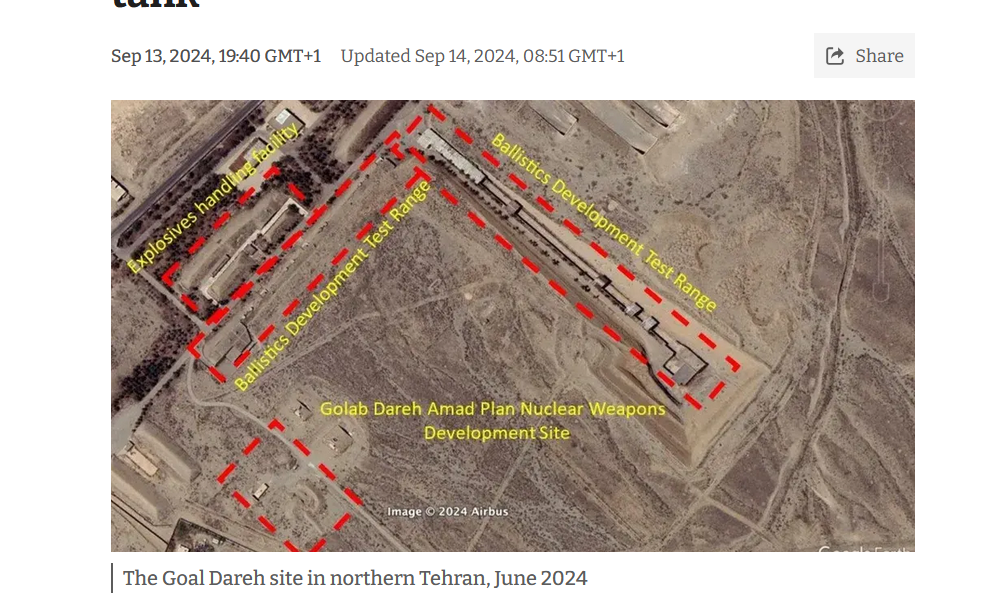
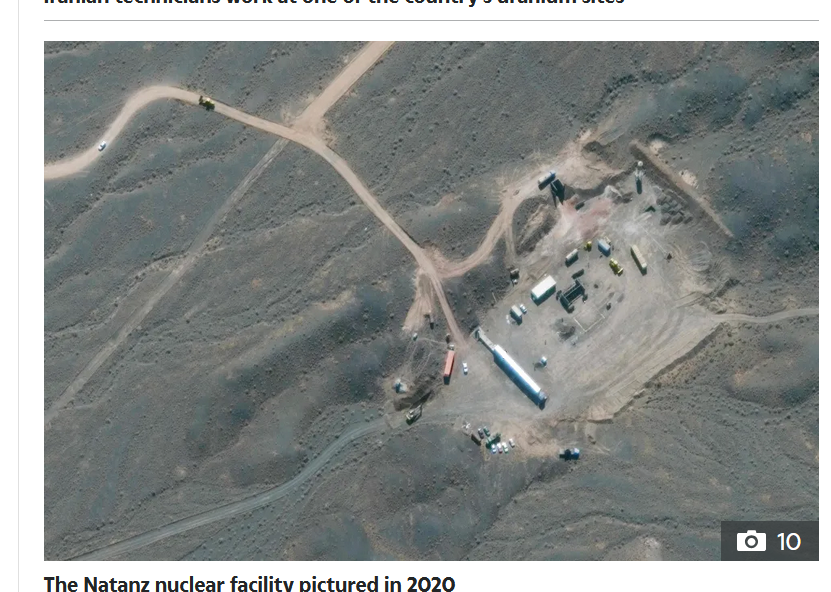
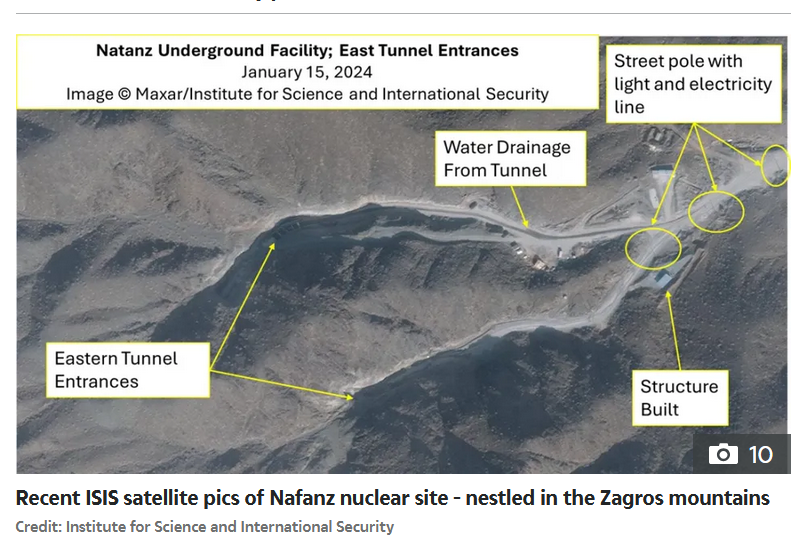
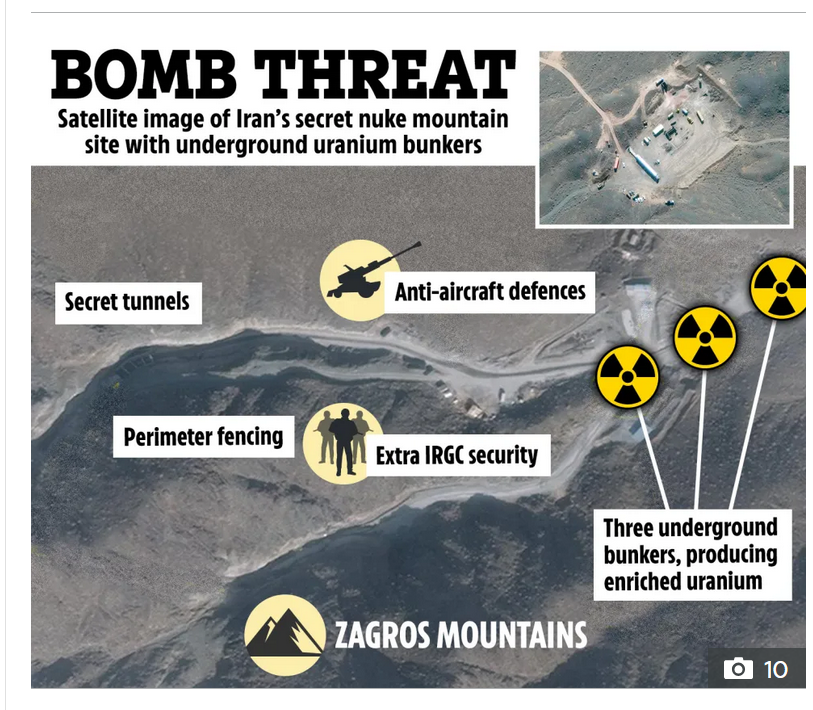

Built around a complicated tunnel network, the complex is nestled into the Kuh-e Kolang Gaz La mountain facility at a depth of between 80 meters (260 feet) and 100 meters (328 feet), surrounded by 2.5 m thick concrete walls. With more entrances and no obvious ventilation shafts, it would be much harder to destroy. It is deeper than at Iran’s other primary underground plant – the Fordow enrichment hub.
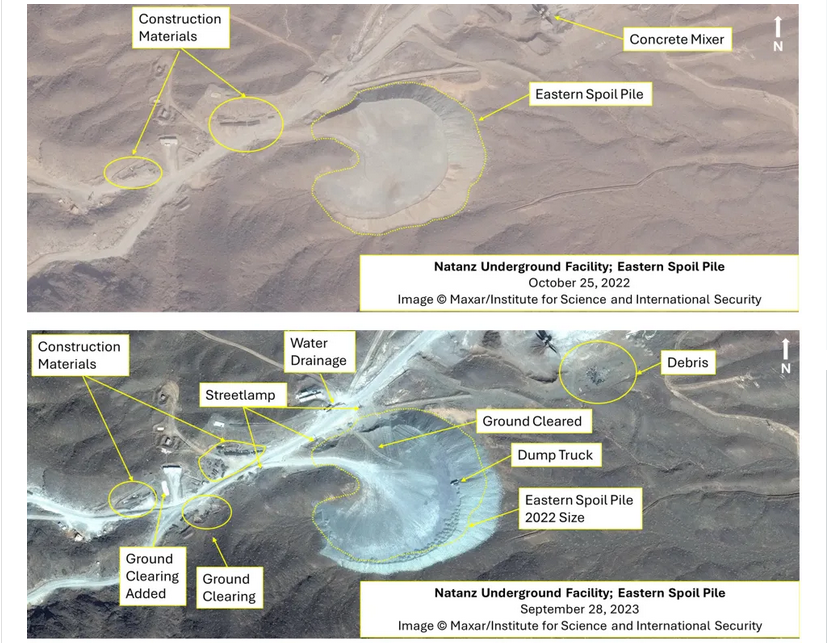

International concerns have swirled over the site as Iran refuses to cooperate with terms laid out by the International Atomic Energy Agency (IAEA).The Nuclear Threat Initiative, a non-profit security watchdog, thinks the huge Natanz complex could be made up of three different underground buildings.It is also believed to be home to three Chinese-supplied research reactors which work on fuel production as well as other nuclear programs.
Will Iran Revise its Nuclear Doctrine?
Iran is a nuclear threshold country, it has the means and capability to assemble nuclear weapons in a short span of time. Iran has been secretly enriching Uranium for the same purpose for a long time now. A fatwa by the Ayatollah Khamenei deemed ‘the use of’ weapons of mass destruction as ‘haram’. Iran always maintains that it wants a peaceful nuclear program but its actions over the years prove otherwise. The regime never mentioned anything about producing and stockpiling it. The fatwa comes from a 2015 speech where he talks about Iran being a victim of weapons of mass destruction and would not want to follow that path.
In 2021, Intelligence minister Mahmoud Alavi said that the Supreme Leader said that nuclear weapons was against the beliefs of Sharia law and the Islamic Republic does not mean to pursue the, but a cornered cat may behave differently from when the cat is set free, suggesting that Iran could revise its fatwa and the Nuclear Doctrine if needs be. Iran has voiced its opinion that the world could not stop Iran from acquiring nuclear weapons.
Iran is severely mistrustful, it will go to any lengths to secure its existence. It has already invested in the idea heavily by funding and aiding its proxies across West Asia. Nuclear Power would be a linchpin to maintain the status quo. Iran’s deterrence strategy is made up of 3 pillars- the Axis of Resistance, its massive collection of missiles and drones. Nuclear weapons would make their case stronger, which is why they would not stop the quest.
Recent Developments
Thirty-nine Iranian lawmakers have called on Iran’s Supreme National Security Council to review the country’s defense doctrine and consider adopting nuclear weapons as the risk of escalation with Israel continues to grow. The MPs argue that Iran’s supreme leader Ali Khamenei can reconsider his religious ban on nuclear weapons on the grounds that the circumstances have changed. They call upon the Supreme Leader to revise his statement forbidding the use of weapons of mass destruction.
Recently, when a 4.5 magnitude seismic event was detected in Iran, the most sought after narrative was that Iran has tested nuclear weapons in its underground facilities and given the ongoing escalation it was possible. The Heritage Foundation, a right-wing think tank in the US, published a report stating that “Iran can produce nuclear weapons far more rapidly than expected.” In July, US Secretary of State Antony Blinken claimed that “instead of being at least a year away from having the breakout capacity of producing fissile material for a nuclear weapon, [Iran] is now probably one or two weeks away.” The statements accompanied a significant increase in Iran’s stockpile of Uranium enriched to the 60 percent level between May and August 2024, as per a report by the International Atomic Energy Agency (IAEA). Notably, Uranium that is enriched up to 60 percent purity is just a short, technical step away from the 90 percent required for nuclear weapons.
Who will be the first to use the Nuclear Weapon?
Let us consider both Israel and Iran separately
- Israel– Israel has time and again voiced its firm belief that the land between the river in Egypt and the Euphrates belongs to the Jews and their descendants. Israel aspires to not only dominate the Levant but the whole of West Asia. In context of the ongoing conflicts Israel has threatened to target Iran’s nuclear and oil facilities. Notwithstanding the recent difference of opinions between Israel and the US, it cannot be denied that any decision to attack these strategic locations in Iran will be a joint decision by Israel and the US. The US is Israel’s biggest military aid provider. It is Israel’s most trusted partner. Israel would not want to jeopardize their relation; given that it exists in a geographic location with Islam as the majority faith.
It is highly unlikely that Iran will drastically escalate the situation before November 5, election day in the US. Though it is a possibility that cannot be ruled out. American Jews play a pro-active part in the US elections by funding the election campaigns and thereby have a sway in what the candidate’s opinion regarding the Zionist state would be. This could justify why the US went back on its statement and still supplied THAAD to the Israeli military. The period from now on till Election day will be vulnerable and perhaps the Israeli government may use this opportunity to launch a fresh offensive against Iran as President Biden would not be in a position to either pull support or prevent them from going to war with the Persian nation. Israel has turned out to be quite unpredictable as the conflict unfolds.
- Iran– Iran is a nuclear threshold nation. It has the capability to assemble nuclear weapons over a short span of time. Even after keeping up a facade of wanting nothing more than a peaceful/civilian nuclear program, Iran has continued to enrich uranium and expand its nuclear facilities and its production power. It has collaborated with multiple state and non-state actors to acquire what it needs to do the same. Iran has always been incalculable. The restraint that Iran has shown till now is truly surprising. Iran already has the means to go on an all out war with Israel, it has an extensive network of dedicated militants but it refrained from doing so. Firstly it played a psychological game by delaying its response and even now it is not showing its complete strength which can only mean that Iran does not intend to be impulsive, it is playing a long game here, it is waiting for a certain piece of the puzzle to fall right into place before it launches a full on war. Iranian officials have reiterated that they intend to respond in a grave manner if its oil or nuclear facilities are attacked.
The whole point of Iran going after a nuclear program is to set itself at par with its Israeli counterpart. Iran also seeks to establish its dominance in West Asia. It is highly apprehensive of the West who would back Israel incase of a war. Following this perspective, Iran would look to have nuclear weapons of its own as possessing it would be the only thing that would keep the west from attacking it.
Conclusion
Nuclear weapons have far reaching consequences, it is quite an inhumane threat but in times of war when all boundaries have been crossed, states desperately use this thunderbolt as the state that possesses it is on a higher ground in terms of steering the negotiation wheel. It is undeniable that they have an upper hand in this regard. Nuclear warfare has the potential to doom the whole planet. A confrontation between Iran and Israel on a nuclear level would have catastrophic humanitarian, environmental and geopolitical consequences. It would draw the whole region into war, triggering widespread destruction and international intervention. It would set off a nuclear arms race where all the countries in the region would run to get their hands on them. The resulting fallout would not only devastate West Asia but also strain global security. Therefore, preventing escalation through diplomacy and effective containment strategies remain of utmost importance to avoid a conflict that could have irreversible consequences.


Leave a Reply